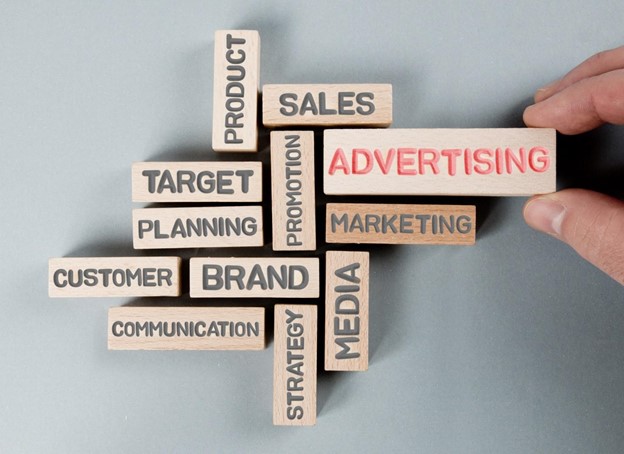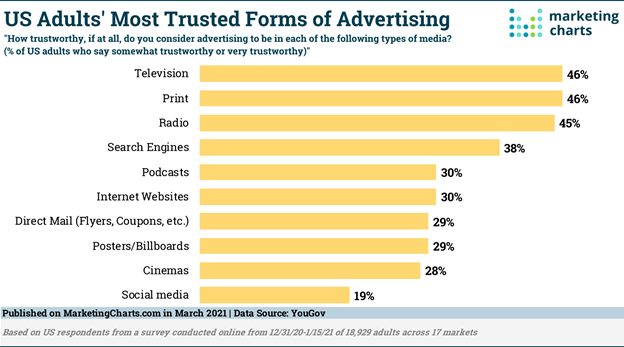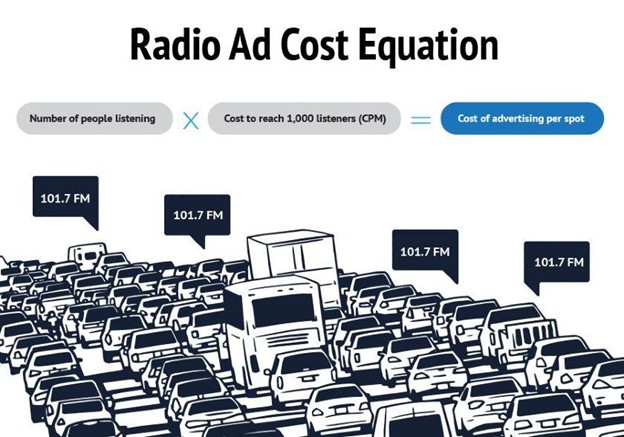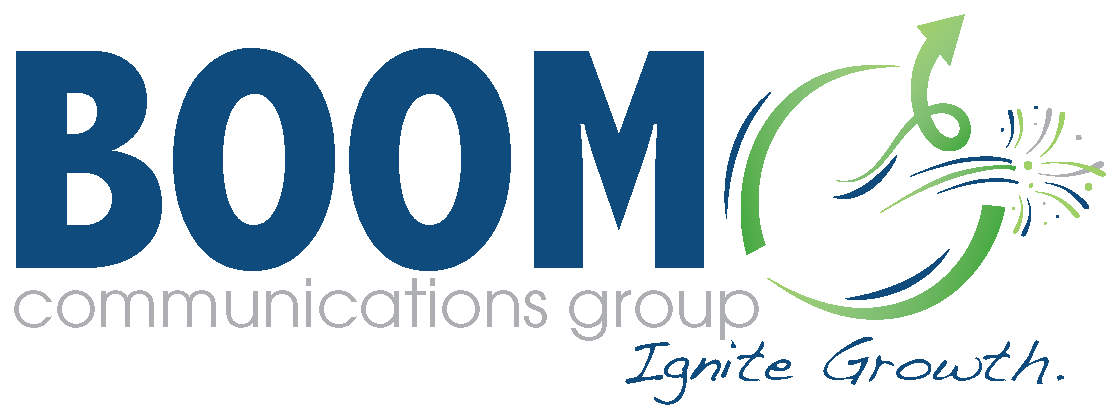
With audiences immersed in so many different media types, how can advertisers reach the most people most cost-effectively? This guide will examine various types of media, including the pros, cons, and average costs of media ad pricing so marketers can understand the options available to them.
We’ll explore:
- Video (television, YouTube, online videos)
- Audio (radio, podcasts)
- Print (newspapers, magazines, brochures, etc.)
- Social Media
- Search Engines
The ultimate goal of advertising media is to engage with your target audience in the most impactful way, depending on demographics and other factors. For example, younger generations are more likely to get their news online rather than from a newspaper, so if you’re targeting Gen Z, a newspaper ad isn’t the best way to reach them.
Which advertising method is the best for your product, service, or brand? Keep reading to learn more about media ad pricing.
Key Takeaways:
- Consumers rank television, print, and radio ads as the most trustworthy forms of advertisement.
- Podcasting is a relatively inexpensive advertising option with promising growth potential.
- Social media is a popular advertising channel, but it’s the least trusted among consumers.
- Google remains the uncontested king of search engines in search engine marketing.
5 Major Advertising Formats for Media Ad Pricing
Before spending money on ad slots, advertisers need to have a thorough understanding of their audience demographics, marketing objectives, and the pros and cons of each media channel:
1. Video Advertising
- Television
- YouTube
- Online
Analysts estimate that there are approximately 121 million TV homes in the United States as of 2021. Although the number of households with at least one television continues to grow, pay TV is becoming less popular as consumers switch to streaming platforms.
Whether it’s displayed on a television, mobile device, or computer screen, video advertising combines audio and visual to create a multi-sensory advertising experience. Television ads are one of the most trusted forms of advertising.

However, keep in mind that even though consumers generally trust TV ads, many of your viewers are prone to skipping, muting, or tuning out video ads altogether.
Another disadvantage: creating video ads can be a significant investment. On top of production expenses, the average TV ad costs about $115,000 for a 30-second commercial on a national news network.
In comparison, most businesses average $0.10 to $0.30 per view or click on YouTube.
2. Audio Advertising
- Radio
- Podcast
In 2020, 83% of Americans 12 or older listened to terrestrial radio. Podcast audiences have been growing steadily, with 41% of Americans 12 and up listening to weekly podcasts in 2021.
Since many people listen to the radio in the car, this type of media is extremely accessible. Media ad pricing for radio slots typically depends on the city, potential population reach, and the number of competing radio stations. A 30-second radio ad slot that costs around $25 in Topeka, KS, could cost $1,405 in New York, NY.

Podcast advertising is a newer form of audio media. Listeners tend to be highly engaged, and the audience numbers continue to grow. In many cases, podcast hosts deliver the promotion. Since they’ve already built a rapport with their audience, listeners tend to find podcast advertisements trustworthy.
However, with audio advertising in any format, there are disadvantages. Many listeners are multitasking, whether they’re driving, working, doing chores, etc., while they listen. Capturing their full attention can be difficult.
3. Print Advertising
- Newspapers
- Magazines
- Brochures, Flyers, Leaflets, etc.
Newspapers are one of the oldest forms of media, but they continue to be an effective advertising option today. Experts project that newspaper ad spending will reach $37.622 million in 2021, while magazine ad spending estimations will reach $15.757 million.
Consumers rank print ads as one of the most trusted mediums. Newspapers have the potential to reach a targeted audience, while magazines and other print ads like local flyers can have even more fine-tuned targeting abilities.
Print newspaper ad pricing varies depending on the publication’s location and circulation size, not to mention other factors like the color, size, number of times, and day of the week your ad is in the paper. Many newspapers are going digital, which reduces the advertising cost.
An ad in a national magazine can run anywhere from $500 to $397,800. Digital publications tend to rely on a pay-per-click (PPC) ad model.
4. Social Media
Social media giants like Instagram, Facebook, TikTok, LinkedIn, YouTube, and Twitter have the potential to tap into a massive audience. Analysts estimate that there were approximately 4.2 billion social media users worldwide in January 2021. In the United States, 82% of the population has a social networking profile.
Social media allows businesses to build a loyal base of followers and extend their brand reach with highly targeted ad campaigns. With real-time data and analytics, companies can easily measure campaign effectiveness and optimize their ad strategy and budget.
However, social media isn’t a perfect advertising solution despite its popularity among consumers and marketers. The 2021 Edelman Trust Barometer revealed that public trust is at an all-time low, and social media is the lowest-rated source of information.

5. Search Engines
Ever wonder how many daily searches Google handles? In 2020, that number was 6.9 billion. That’s about 2.5 trillion searches per year.
Google dominates the search engine market. In September 2021, Google held a whopping 86.64% of the global search market. In comparison, Bing had nearly 7%, and Yahoo’s market share was 2.75%.
Google Ad pricing has a high variability depending on your industry, current search trends, keyword bid, budget, ad rank, quality score, targeting settings, and customer lifecycles.

Google Ads operates on an auction system, which means advertisers have to bid on specific keywords. The good news is the platform runs on a PPC structure, so your cost depends on how many users click on your ad, not how many times your ad is displayed.
Most companies pay an average of $9,000 to $10,000 per month. Google Ads are an excellent way to target in-market shoppers, but it isn’t always the best advertising option for small businesses due to the highly competitive bidding process.
Strategize Your Media Ad Pricing to Maximize Your Marketing Budget
Your ad dollars are limited, so make sure you’re using them wisely. Advertising requires careful preplanning and strategizing before you start spending your valuable marketing budget.
You’ve probably heard the phrase “don’t put all of your eggs in one basket,” right? You also shouldn’t put all of your advertising money into one form of media. The most effective marketers pick a few of their best options to diversify their reach.
Need help with your marketing strategy? Contact Boom Communications Group to learn how we can boost your advertising.
